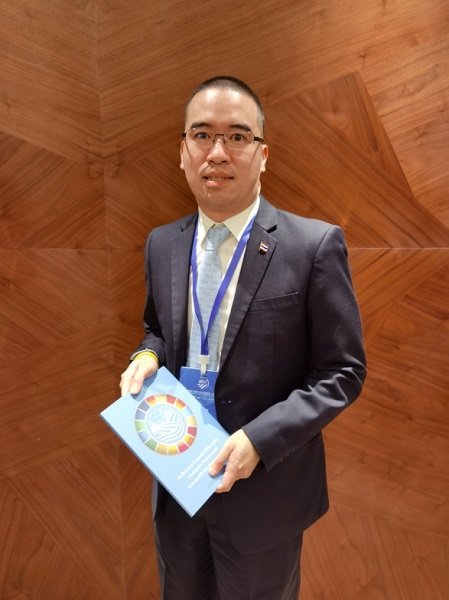China’s State Council Information Office released the white paper Biodiversity Conservation in China on October 8, 2021 to introduce the actions China has taken on biodiversity conservation and the achievements it has made in the sector. According to the white paper, China is forming a new pattern of biodiversity conservation by preserving biodiversity with creative and up-to-date measures.
China Today interviewed consuls of Malaysia, Thailaind, and Cambodia in Kunming on October 9, right before the the 15th meeting of the Conference of the Parties (COP15) to the Convention on Biological Diversity. They shared their views on China’s efforts in biodiversity conservation and environmental protection and expressed their wiliness to promote more exchanges between China and member countries of the Association of Southeast Asian Nations (ASEAN) in these fields.
Exchanges in a Multilateral Platform
Faizal Shani, consul general of Malaysia in Kunming, said that he was deeply impressed with some statistics in the white paper about China’s biodiversity conservation. For example, China has established close to 10,000 protected areas of all types and at all levels, accounting for about 18 percent of its total land area. The population of giant pandas in the wild has grown from 1,114 to 1,864 over the past four decades.

Faizal Shani, consul general of the Consulate General of Malaysia in Kunming.
He further pointed out that this year marks the 30th anniversary of the dialogue between China and ASEAN. Over the past three decades, China and ASEAN member countries have carried out active and pragmatic cooperation in jointly addressing climate change and biodiversity loss challenges, including both technical exchanges and information sharing in many specific fields. For example, the China-ASEAN Environmental Cooperation Center has been set up, and China has launched and implemented with ASEAN member states a number of cooperation initiatives that include the China-ASEAN Cooperation Plan on Biodiversity and Ecological Conservation and the Southeast Asia Biodiversity Research Institute of the Chinese Academy of Sciences which was unveiled in 2015 to carry out joint field studies and major scientific research as well as provide policy consultation and personnel training.
“Facts have proved that if we only focus on economic growth but ignore sustainable development, we will pay a heavy price for it,” Faizal Shani said, and then pointed out that this is why all countries are looking forward to the convening of the COP15, “because it will prompt us to do more in-depth exploration on how to keep a harmonious relation between human and nature and gain further development.”
Faizal Shani noted that the upcoming COP15 will build a platform for mutual exchanges between governments, international and non-governmental organizations, think tanks, and companies. “It is a multilateral platform, through which different countries can reach consensuses on policy making. For both developed or developing countries, it is a rewarding effort as we are in a community with a shared future for humankind,” he said.
Calling for Closer Mutual Cooperation
Cambodia has been keeping close attention to China’s achievements in environmental protection. Iem Puthviro, Cambodian consul general in Kunming, said he was impressed that China has designated 35 priority areas for biodiversity preservation, among which 32 terrestrial priority areas cover an area of 2.76 million square kilometers and make up about 28.8 percent of the total land area. “They are valuable in effectively protecting key ecosystems, species, and their habitats,” he added.

Iem Puthviro, consul general of the Consulate General of the Kingdom of Cambodia in Kunming.
“We hope to learn from China and will persist in the conservation of biological diversity. We must carry out closer cooperation, share our technologies and resources, and send personnel to learn from each other. This is beneficial to the development of both my country andour region,” said Iem Puthviro.
Lancang River, which originates from China’s Qinghai-Tibet Plateau, is called the Mekong River after flowing into the Indochina Peninsula. It is the longest river in Southeast Asia, flowing through six countries in total. China and the countries along the river have established a center for the Lancang-Mekong environmental cooperation and host regular roundtable meetings that focus on ecosystem management and biodiversity conservation. Fruitful results have been achieved as a result of the meetings in the sectors of biodiversity conservation, corridor planning and management, and community livelihood improvement.
Sharing the Same Philosophy of Development
Vorapong Vadhanasindhu, a consul at Royal Thai Consulate General in Kunming, believes that environmental protection and sustainable development has become a global issue. The white paper issued by the Chinese government fully explained the new achievements China has made in biodiversity conservation as well as the great contributions it has made to address global biodiversity challenges. It’s necessary for countries to learn from each other and share experiences.

Vorapong Vadhanasindhu, consul of the Royal Thai Consulate General in Kunming.
“For the common goal, Thailand has also taken similar measures and actions, and is presently drafting the master plan and a new law on biodiversity conservation. It is vital to promote global biodiversity conservation,” Vorapong Vadhanasindhu said, and then added, “The Thailand government is willing to share experience with China and jointly promote biodiversity conservation and sustainable development.”
He indicated that China has always upheld the philosophy of harmonious coexistence of humanity and nature, prioritized biodiversity conservation, and pursued green development; while Thailand also shares the similar philosophy, putting emphasis on the balance between economic development and environmental protection, and has rolled out many initiatives on the protection of water resources, forests, soil, animals and plants, and sustainable agriculture. Vorapong Vadhanasindhu believes that the pursuit of both Thailand and China of an ecological, circular, and green economic model in the process of economic development will make great contributions to global biodiversity conservation.